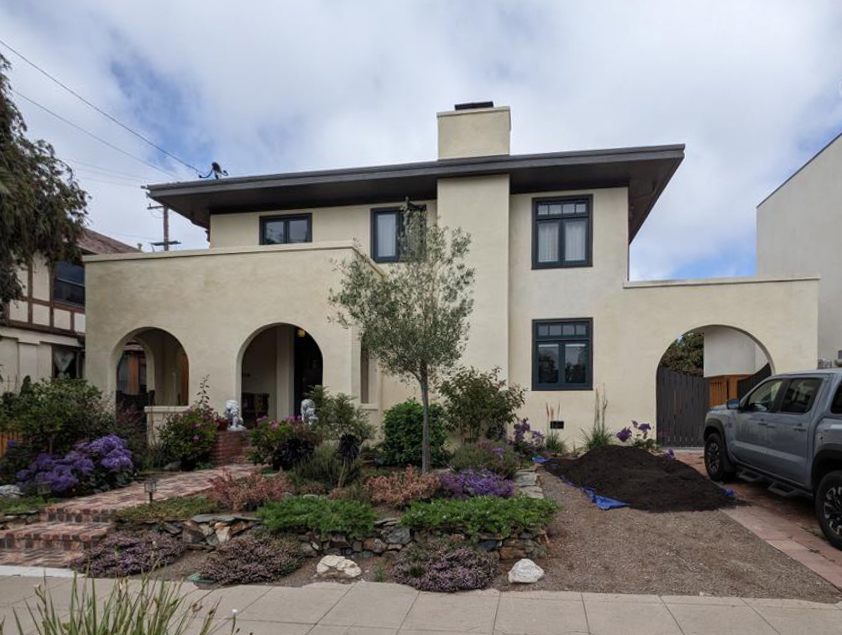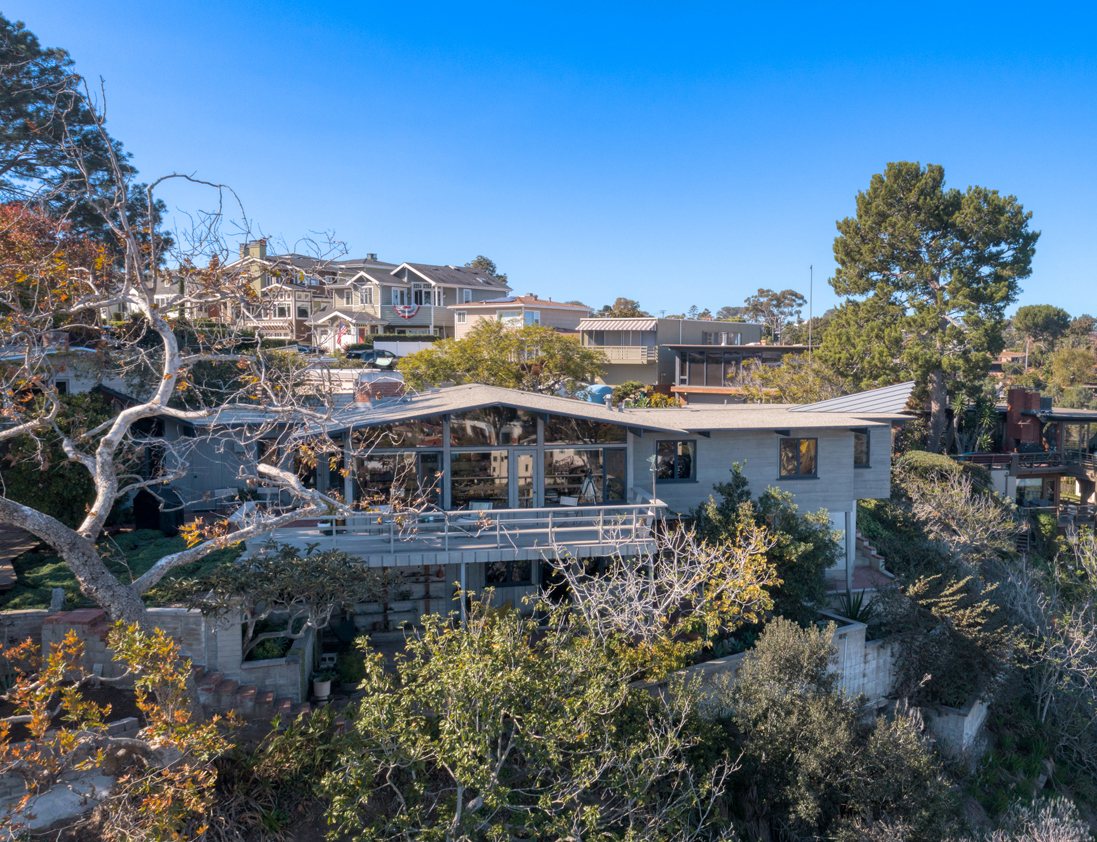|
2024 Year in Review Countywide Historic Designation
Intro by Ann Jarmusch
January/February 2025
 |
 |
In 2024, the City of San Diego Historical Resources Board designated 29 historical resources, 26 which are single-family residences. These are two of the most architecturally significant among them. Left The George and Maud Easton House, designed by Irving J. Gill in 1908, blends Prairie and Mission Revival styles. Right Sim Bruce Richards designed this site-specific Modern Organic Geometric house for him and his wife, Janet, and family (1956-1957). They were designated in August and September 2024, respectively. Easton House photo courtesy the California Historical Resources Inventory Database (CHRID); Richards House photo by Andrei Booriakin |
Developments in preservation in San Diego began at a gallop last year, and never slowed down. In February 2024, the City of San Diego launched its still-ongoing Preservation and Progress initiative to update and overhaul heritage preservation policies, procedures, and perhaps the 1965 ordinance itself. (Read about it online).
It seemed to SOHO and other preservationists that the update’s true goal is to make building permits and approvals even friendlier than in recent years to developers who falsely complain that protecting historic architecture and sites delays or prevents them from fulfilling a great civic need: the production of affordable housing.
HRB approval of the Hillcrest Focused Plan Amendment Historic Preservation Component in May bolstered the view that the city favors developers over preserving our shared heritage. “As written, the plan would allow too much destruction of historic material,” SOHO’s executive director Bruce Coons told the HRB. It would also allow taller buildings, greater density, and inadequate setbacks, irreparably damaging Hillcrest’s appealing historic character.
Throughout 2024, citizen input into the city’s controversial preservation update was limited to making online comments via a Preservation and Progress portal. SOHO, the Neighborhood Historic Preservation Coalition, and others repeatedly asked for public meetings to exchange ideas and concerns with city officials, but none was scheduled.
Meanwhile, neighborhood preservationists organized themselves with far-reaching civic consequences. Public comment at the city’s monthly Historical Resources Board meetings reached an all-time high for a decade or more. Groups and individuals with proposals to streamline the city’s process of adding three new National Historic Districts to the local register hit a wall when the HRB pushed the residents’ repeated requests for change into the lengthy Preservation and Progress project.
Led by SOHO and others, preservationists also strongly urged the city to resume processing more than two dozen well-documented local historic district nominations, many of which have been languishing for years. The city last approved a historic district in 2017. “The city’s backlog may not be cleared for decades,” Coons warned during an HRB meeting. While we wait, scores of historic resources are being altered, damaged, or neglected, so that they may no longer qualify for designation. Or they may be lost forever.
Homeowners in the Valle Vista Terrace Historic District in University Heights were similarly frustrated by unanswered appeals for city staff intervention. As the HRB’s monthly meetings ticked by with no response to their red flags, the residents watched a three-story ADU (accessory dwelling unit) being built behind a historic home in their mostly one-story neighborhood. They had agreed, they argued, to abide by the city’s historic district rules. Why was one owner being allowed to sabotage the community’s good faith and priceless heritage? The city’s reply may be forthcoming at the January 23, 2025, HRB meeting.
City representatives announced good news and sobering news. A $40,000 grant will fund the Heritage Preservation staff’s creation of an essential tool: the first historic context statement for the entire city. The sobering development: In July 2024, San Diego sharply raised its fees for nominating buildings for designation and for evaluating and administering Mills Act contracts with historic property owners. This fiscal move risks excluding even more residents than before from being able to afford a historic home. Even if they own a historic property, they may be priced out of applying for designation and the city’s preservation benefits and protections tied to that status.
In San Diego, the year ended on a dismaying note, with only 29 properties landmarked by the HRB—compared to 37 in each of 2022 and 2023, and a total of 48 in 2021. The 2024 designations include 26 homes plus three other resources: an important archaeological tool making site in Otay Mesa (documented before its planned destruction for a housing development), a 1926 apartment building still in use, and the 1966 San Diego International Sports Arena, which is slated for redevelopment.
Follow the links below for a rewarding tour of the city of San Diego’s 2024 historically designated homes and other properties in many architectural styles and settings.
Don’t miss the Tudor Revival style home Edgar Ullrich designed for his family in 1925-1926, which was designated in November 2024. Wrapped around the front door is a tall bas relief featuring two monkeys holding the Ullrich family crest. The architect was responding to the 1925 Scopes Monkey Trial over teaching evolution in public schools and signaling his support of Darwin’s theory of evolution.
January/February
March/April
May/June
July/August
September/October
November
BACK to the table of contents
|
2025
2024
2023
2022
2021
2020
2019
2018
2017
2016
2015
|





